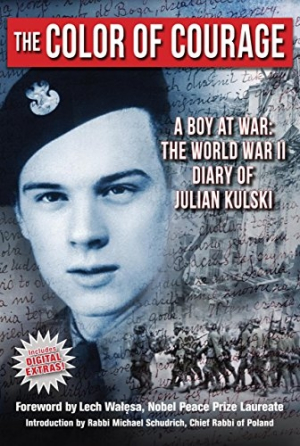The Color of Courage
A Boy at War: The World War II Diary of Julian Kulski
- 2014 INDIES Finalist
- Finalist, War & Military (Adult Nonfiction)
Kulski’s story heart-wrenchingly follows the arc of a boy becoming a young man in World War II Poland.
The Color of Courage is the chronological diary of Julian Kulski, who was ten years old when Germany invaded his native Poland in 1939. Transitioning from the Boy Scouts to the Polish Underground Army, through the Warsaw Ghetto and the event of the Warsaw Uprising, Kulski ends up a sixteen-year-old German prisoner of war; but his story doesn’t end there. This gripping personal account brings a deeply moving and unique perspective to World War II Poland.
Kulski’s father was deputy mayor of Warsaw when the war began and would serve as mayor through the war years, treading the fine line of serving his fellow citizens while appearing to serve their occupiers. Kulski was therefore a privileged youth; he chafes when the Germans curtail his free movements throughout the city. But as the war progresses and the Warsaw Ghetto is established—and his Jewish girlfriend is sent to live there and eventually presumed dead—he matures, and his desire to participate in the resistance solidifies, even as he comes to fully comprehend what that will entail. He serves in the Polish Underground Army (Home Army), makes a secret mission into the Ghetto, is arrested by the Gestapo and sentenced to be detained in Auschwitz (a fate he narrowly avoids), and eventually fights in the Warsaw Uprising. Kulski finishes the war in a German POW camp, but rather than awaiting the release of Polish prisoners, he sneaks out early with the Americans; his adult life in the United States receives only a few pages’ attention, but makes a fittingly successful ending to a heartrending and sympathetic odyssey.
Kulski’s utterly wrenching, heartfelt, and visceral narrative spans the war years, 1939-1945. The child’s outrage at the upheaval of his everyday life and limitations on his freedoms is duly captured; but his voice rarely feels like that of a child, perhaps because he didn’t write until just after the war. He states that he used a calendar to recreate events he’ll never forget. Kulski’s writing style is not lyrical or literary, yet it includes thought-provoking philosophies and musings and is refined beyond any need to use its war-diary genre as excuse. In all, The Color of Courage is a compelling and polished read with its own irresistible momentum. Supporting photographs, maps, and documents interspersed throughout his chronicle make it quicker and faster-paced than its 400 pages would indicate.
Poignant, haunting, gritty, and bursting with realism, Julian Kulski’s diary of seven years in World War II Warsaw is a powerful eyewitness and participant accounting of a singular experience. Obviously for the fan of military history, The Color of Courage will likewise appeal to readers of memoir and broader-scope credible histories, and its emotional impact is sufficient to enthrall a diverse audience.
Reviewed by
Julia Jenkins
Disclosure: This article is not an endorsement, but a review. The publisher of this book provided free copies of the book to have their book reviewed by a professional reviewer. No fee was paid by the publisher for this review. Foreword Reviews only recommends books that we love. Foreword Magazine, Inc. is disclosing this in accordance with the Federal Trade Commission’s 16 CFR, Part 255.

